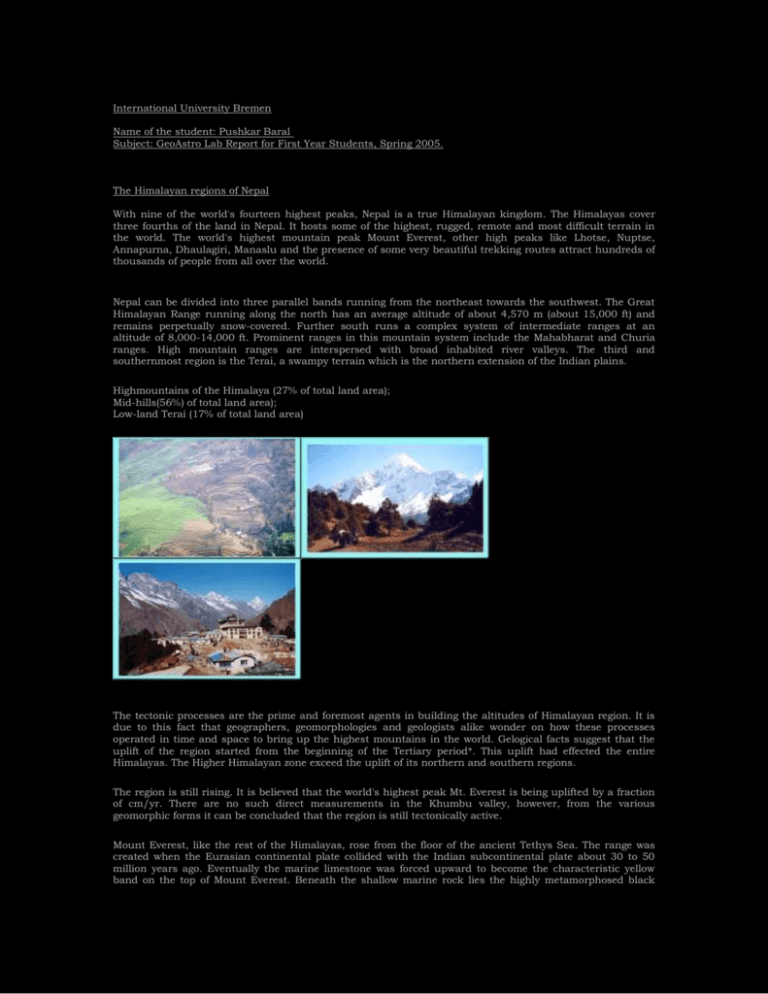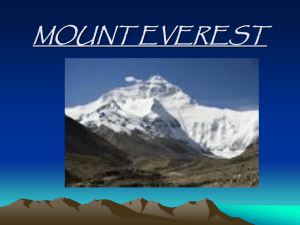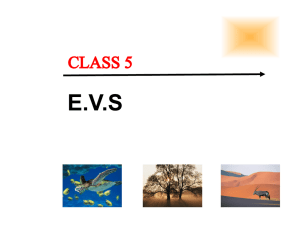Labreport PBaral
advertisement

International University Bremen Name of the student: Pushkar Baral Subject: GeoAstro Lab Report for First Year Students, Spring 2005. The Himalayan regions of Nepal With nine of the world's fourteen highest peaks, Nepal is a true Himalayan kingdom. The Himalayas cover three fourths of the land in Nepal. It hosts some of the highest, rugged, remote and most difficult terrain in the world. The world's highest mountain peak Mount Everest, other high peaks like Lhotse, Nuptse, Annapurna, Dhaulagiri, Manaslu and the presence of some very beautiful trekking routes attract hundreds of thousands of people from all over the world. Nepal can be divided into three parallel bands running from the northeast towards the southwest. The Great Himalayan Range running along the north has an average altitude of about 4,570 m (about 15,000 ft) and remains perpetually snow-covered. Further south runs a complex system of intermediate ranges at an altitude of 8,000-14,000 ft. Prominent ranges in this mountain system include the Mahabharat and Churia ranges. High mountain ranges are interspersed with broad inhabited river valleys. The third and southernmost region is the Terai, a swampy terrain which is the northern extension of the Indian plains. Highmountains of the Himalaya (27% of total land area); Mid-hills(56%) of total land area); Low-land Terai (17% of total land area) The tectonic processes are the prime and foremost agents in building the altitudes of Himalayan region. It is due to this fact that geographers, geomorphologies and geologists alike wonder on how these processes operated in time and space to bring up the highest mountains in the world. Gelogical facts suggest that the uplift of the region started from the beginning of the Tertiary period*. This uplift had effected the entire Himalayas. The Higher Himalayan zone exceed the uplift of its northern and southern regions. The region is still rising. It is believed that the world's highest peak Mt. Everest is being uplifted by a fraction of cm/yr. There are no such direct measurements in the Khumbu valley, however, from the various geomorphic forms it can be concluded that the region is still tectonically active. Mount Everest, like the rest of the Himalayas, rose from the floor of the ancient Tethys Sea. The range was created when the Eurasian continental plate collided with the Indian subcontinental plate about 30 to 50 million years ago. Eventually the marine limestone was forced upward to become the characteristic yellow band on the top of Mount Everest. Beneath the shallow marine rock lies the highly metamorphosed black gneiss (foliated, or layered, rock) of the Precambrian era, a remnant of the original continental plates that collided and forced up the Himalayas. Mount Everest is covered with huge glaciers that descend from the main peak and its nearby satellite peaks. The mountain itself is a pyramid-shaped horn, sculpted by the erosive power of the glacial ice into three massive faces and three major ridges, which soar to the summit from the north, south, and west and separate the glaciers. From the south side of the mountain, in a clockwise direction, the main glaciers are the Khumbu glacier, which flows northeast before turning southwest; the West Rongbuk glacier in the northwest; the Rongbuk glacier in the north; the East Rongbuk glacier in the northeast; and the Kangshung glacier in the east. The large number of trekkers and climbers who visit Nepal and the Everest region contribute to the local economy but also cause serious environmental impact. Such impact includes the burning of wood for fuel, pollution in the form of human waste and trash, and abandoned climbing gear, etc. Although some climbing gear is recycled by local residents either for their own use or for resale, it is estimated that more than 50 tons of plastic, glass, and metal were dumped between 1953 and the mid-1990s in what has been called “the world’s highest junkyard.” Up on the ice, where few local people go, the norm is to throw trash into the many crevasses, where it is ground up and consumed by the action of the ice. A few bits and pieces show up on the lower part of the glacier many years later as they are churned back to the surface, although organic matter is generally consumed or scavenged by local wildlife. At the high-elevation camps, used oxygen bottles are strewn everywhere. Efforts have been made to reduce the negative environmental impact on Mount Everest. The Nepalese government has been using a portion of climbing fees to clean up the area. In 1976, with aid from Sir Edmund Hillary’s Himalayan Trust and the Nepalese government, the Sagarmatha National Park was established to preserve the remaining soil and forest around Mount Everest. By the mid-1990s the park comprised 1,240 sq km (480 sq mi). Trekking and climbing groups must bring their own fuel to the park (usually butane and kerosene), and the cutting of wood is now prohibited. Because the freedoms of Sherpas have been restricted by the park rules, they have not been sympathetic to the existence of the park. Additionally, the Sagarmatha Pollution Control, funded by the World Wildlife Fund and the Himalayan Trust, was established in 1991 to help preserve Everest’s environment. Climbing activity continues to increase, however, and the environmental future of the Mount Everest area remains uncertain Efforts have been made to reduce the negative environmental impact on Mount Everest. The Nepalese government has been using a portion of climbing fees to clean up the area. In 1976, with aid from Sir Edmund Hillary’s Himalayan Trust and the Nepalese government, the Sagarmatha National Park was established to preserve the remaining soil and forest around Mount Everest. By the mid-1990s the park comprised 1,240 sq km (480 sq mi). Trekking and climbing groups must bring their own fuel to the park (usually butane and kerosene), and the cutting of wood is now prohibited. Because the freedoms of Sherpas have been restricted by the park rules, they have not been sympathetic to the existence of the park. Additionally, the Sagarmatha Pollution Control, funded by the World Wildlife Fund and the Himalayan Trust, was established in 1991 to help preserve Everest’s environment. Climbing activity continues to increase, however, and the environmental future of the Mount Everest area remains uncertain. The Inventa Everest Environmental Expedition is devoting months to collecting trash from Everest's higher camps. The team, which includes about two-dozen Sherpas, will use extra-large backpacks to transport the trash to the base of Mt. Everest. Once sorted, burnable and biodegradable trash will either be incinerated or composted. Other trash such as recyclables, will be flown to Kathmandu and then shipped to the United States. The oxygen bottles will be used to raise money in future fundraisers. Also, the major river system of Nepal rely directly on these Himalayas for their perennial flow; their Deglaciation and glacier retreats are the most pressing and important issues affecting the hydrological behaviour of the major river systems of the region. These rely totally on the snow and glaciers of the Himalayas for their perennial flow. Studies have shown that glaciers in this region have been in a general state of retreat since 1850, although examples of both advancing and retreating glaciers have been reported from the Karakoram and Kunlun Mountains. As a consequence, the number of glacial lakes in the eastern Himalayas, in Nepal and Bhutan is increasing with increased vulnerability to glacial lake outburst floods. It is therefore important that the impacts of global warming on snow and glacier melting and hence water resources are fully understood. Floods and droughts are other major events that dominate the headlines of newspapers in the region every year during monsoon and dry periods. Floods can include glacial lake outburst floods, landslide dammed flash floods, high rainfall-induced floods and floods in ephemeral rivers (which remain dry for almost eight months a year). The region has witnessed major climate-induced disasters in recent years, such as the major disaster caused by floods and debris flow in south-central Nepal in July 1993. It is difficult to definitely relate these events to climate change. Water quality is another major concern, particularly during low flows, with increasing pollution of surface and ground waters. Water scarcity is growing rapidly with the increasing demands of a growing population, urbanisation and industrialisation. Groundwaters are being exploited recklessly, lowering the water table. Arsenic contamination of groundwater, is a major problem for which solutions have so far been elusive. A low priority is given to investment on hydrological and meteorological research in Nepal, where scientific research is not prioritized. It is therefore important to undertake projects that highlight the benefits of hydrological research, not only to develop the rich hydropower and irrigation potential, but also to save life and property from floods, which are occurring with increasing frequency and magnitude. To what extent such demands can be met depends very largely on the ability to manage water effectively. ***********The end********************** *Tertiary Period is a part of the Cenozoic Era, referring to 2 to 65 millions year ago. Source: www.nwl.ac.uk







